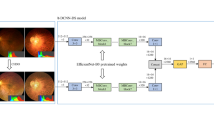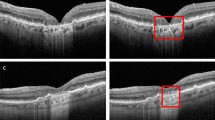Abstract
Myopic macular degeneration is the most common complication of myopia and the primary cause of vision loss in individuals with pathological myopia. Early detection and prompt treatment are crucial in preventing vision impairment due to myopic maculopathy. This was the focus of the Myopic Maculopathy Analysis Challenge (MMAC), in which we participated. In task 1, classification of myopic maculopathy, we employed the contrastive learning framework, specifically SimCLR, to enhance classification accuracy by effectively capturing enriched features from unlabeled data. This approach not only improved the intrinsic understanding of the data but also elevated the performance of our classification model. For Task 2 (segmentation of myopic maculopathy plus lesions), we have developed independent segmentation models tailored for different lesion segmentation tasks and implemented a test-time augmentation strategy to further enhance the model’s performance. As for Task 3 (prediction of spherical equivalent), we have designed a deep regression model based on the data distribution of the dataset and employed an integration strategy to enhance the model’s prediction accuracy. The results we obtained are promising and have allowed us to position ourselves in the Top 6 of the classification task, the Top 2 of the segmentation task, and the Top 1 of the prediction task. The code is available at https://github.com/liyihao76/MMAC_LaTIM_Solution.
Access this chapter
Tax calculation will be finalised at checkout
Purchases are for personal use only
Similar content being viewed by others
References
Chaurasia, A., Culurciello, E.: Linknet: Exploiting encoder representations for efficient semantic segmentation. In: 2017 IEEE Visual Communications and Image Processing (VCIP), pp. 1–4. IEEE (2017)
Chen, L.C., Zhu, Y., Papandreou, G., Schroff, F., Adam, H.: Encoder-decoder with atrous separable convolution for semantic image segmentation. In: Proceedings of the European Conference on Computer Vision (ECCV), pp. 801–818 (2018)
Chen, T., Kornblith, S., Norouzi, M., Hinton, G.: A simple framework for contrastive learning of visual representations. In: Proceedings of the 37th International Conference on Machine Learning, ICML’20, JMLR.org (2020)
Dai, L., et al.: A deep learning system for detecting diabetic retinopathy across the disease spectrum. Nat. Commun. 12(1), 3242 (2021)
Dosovitskiy, A., et al.: An image is worth 16x16 words: transformers for image recognition at scale. CoRR abs/2010.11929 (2020). https://arxiv.org/abs/2010.11929
El Habib Daho, M., et al.: Improved automatic diabetic retinopathy severity classification using deep multimodal fusion of UWF-CFP and OCTA images. In: Antony, B., Chen, H., Fang, H., Fu, H., Lee, C.S., Zheng, Y. (eds.) Ophthalmic Medical Image Analysis. OMIA 2023. LNCS, vol. 14096, pp. 11–20. Springer, Cham (2023). https://doi.org/10.1007/978-3-031-44013-7_2
Fan, T., Wang, G., Li, Y., Wang, H.: Ma-net: A multi-scale attention network for liver and tumor segmentation. IEEE Access 8, 179656–179665 (2020)
Gwenolé, Q., Hassan, A.H., Mathieu, L., Pierre-Henri, C., Pascale, M., Béatrice, C.: Explain: explanatory artificial intelligence for diabetic retinopathy diagnosis. Med. Image Anal. 72 (2021). https://doi.org/10.1016/j.media.2021.102118
He, K., Zhang, X., Ren, S., Sun, J.: Deep residual learning for image recognition. CoRR abs/1512.03385 (2015). https://arxiv.org/abs/1512.03385
He, K., Zhang, X., Ren, S., Sun, J.: Deep residual learning for image recognition. In: Proceedings of the IEEE Conference on Computer Vision and Pattern Recognition, pp. 770–778 (2016)
Holden, B.A., et al.: Global prevalence of myopia and high myopia and temporal trends from 2000 through 2050. Ophthalmology 123(5), 1036–1042 (2016)
Huang, G., Liu, Z., Van Der Maaten, L., Weinberger, K.Q.: Densely connected convolutional networks. In: Proceedings of the IEEE Conference on Computer Vision and Pattern Recognition, pp. 4700–4708 (2017)
Ikuno, Y.: Overview of the complications of high myopia. Retina 37(12), 2347–2351 (2017)
Isensee, F., Jaeger, P.F., Kohl, S.A., Petersen, J., Maier-Hein, K.H.: nnU-net: a self-configuring method for deep learning-based biomedical image segmentation. Nat. Methods 18(2), 203–211 (2021)
Kirillov, A., He, K., Girshick, R., Dollár, P.: A unified architecture for instance and semantic segmentation. In: CVPR (2017)
Kwon, G., Kim, E., Kim, S., Bak, S., Kim, M., Kim, J.: Bag of tricks for developing diabetic retinopathy analysis framework to overcome data scarcity. In: Sheng, B., Aubreville, M. (eds.) Mitosis Domain Generalization and Diabetic Retinopathy Analysis. MIDOG DRAC 2022 2022. LNCS, vol. 13597, pp. 59–73. Springer, Cham (2023). https://doi.org/10.1007/978-3-031-33658-4_7
Lahsaini, I., El Habib Daho, M., Chikh, M.A.: Deep transfer learning based classification model for covid-19 using chest CT-scans. Pattern Recogn. Lett. 152, 122–128 (2023). https://doi.org/10.1016/j.patrec.2021.08.035
Lakshminarayanan, B., Pritzel, A., Blundell, C.: Simple and scalable predictive uncertainty estimation using deep ensembles. In: Advances in Neural Information Processing Systems, vol. 30 (2017)
Li, L.F., et al.: Deep learning system to predict the 5-year risk of high myopia using fundus imaging in children. NPJ Digit. Med. 6(10) (2023). https://doi.org/10.1038/s41746-023-00752-8
Li, Y., et al.: Segmentation, classification, and quality assessment of UW-OCTA images for the diagnosis of diabetic retinopathy. In: Sheng, B., Aubreville, M. (eds.) Mitosis Domain Generalization and Diabetic Retinopathy Analysis. MIDOG DRAC 2022 2022. LNCS, vol. 13597, pp. 146–160. Springer, Cham (2023). https://doi.org/10.1007/978-3-031-33658-4_14
Liu, R., et al.: Deepdrid: diabetic retinopathy-grading and image quality estimation challenge. Patterns 3(6), 100512 (2022)
Liu, Z., et al.: Swin transformer: Hierarchical vision transformer using shifted windows. CoRR abs/2103.14030 (2021). https://arxiv.org/abs/2103.14030
Ohno-Matsui, K., et al.: International photographic classification and grading system for myopic maculopathy. Am. J. Ophthalmol. 159(5), 877–883 (2015)
Qian, B., et al.: Drac: diabetic retinopathy analysis challenge with ultra-wide optical coherence tomography angiography images. arXiv preprint arXiv:2304.02389 (2023)
Qin, X., Zhang, Z., Huang, C., Dehghan, M., Zaiane, O.R., Jagersand, M.: U2-net: Going deeper with nested u-structure for salient object detection. Pattern Recogn. 106, 107404 (2020)
Silva, R.: Myopic maculopathy: a review. Ophthalmologica 228(4), 197–213 (2012)
Simonyan, K., Zisserman, A.: Very deep convolutional networks for large-scale image recognition. arXiv preprint arXiv:1409.1556 (2014)
Tan, M., Le, Q.: Efficientnet: Rethinking model scaling for convolutional neural networks. In: International Conference on Machine Learning, pp. 6105–6114. PMLR (2019)
Tan, M., Le, Q.: Efficientnetv2: Smaller models and faster training. In: International Conference on Machine Learning, pp. 10096–10106. PMLR (2021)
Yokoi, T., Ohno-Matsui, K.: Diagnosis and treatment of myopic maculopathy. Asia-Pacific J. Ophthalmol. 7(6), 415–421 (2018)
Yue, Z., et al.: Performances of artificial intelligence in detecting pathologic myopia: a systematic review and meta-analysis. Eye (2023). https://doi.org/10.1038/s41433-023-02551-7
Zeghlache, R., et al.: Longitudinal self-supervised learning using neural ordinary differential equation. In: Rekik, I., Adeli, E., Park, S.H., Cintas, C., Zamzmi, G. (eds.) Predictive Intelligence in Medicine. PRIME 2023. LNCS, vol. 14277, pp. 1–13. Springer, Cham (2023). https://doi.org/10.1007/978-3-031-46005-0_1
Zeghlache, R. et al.: Detection of Diabetic Retinopathy Using Longitudinal Self-supervised Learning. In: Antony, B., Fu, H., Lee, C.S., MacGillivray, T., Xu, Y., Zheng, Y. (eds.) Ophthalmic Medical Image Analysis. OMIA 2022. LNCS, vol. 13576, pp. 43–52. Springer, Cham (2022). https://doi.org/10.1007/978-3-031-16525-2_5
Zhao, H., Shi, J., Qi, X., Wang, X., Jia, J.: Pyramid scene parsing network. In: Proceedings of the IEEE Conference on Computer Vision and Pattern Recognition, pp. 2881–2890 (2017)
Zhou, Z., Rahman Siddiquee, M.M., Tajbakhsh, N., Liang, J.: UNet++: a nested u-net architecture for medical image segmentation. In: Stoyanov, D., et al. (eds.) DLMIA/ML-CDS -2018. LNCS, vol. 11045, pp. 3–11. Springer, Cham (2018). https://doi.org/10.1007/978-3-030-00889-5_1
Acknowledgements
The work was conducted in the framework of the ANR RHU project Evired. This work benefited from state aid managed by the French National Research Agency under the “Investissement d’Avenir” program, reference ANR-18-RHUS-0008.
Author information
Authors and Affiliations
Corresponding author
Editor information
Editors and Affiliations
Rights and permissions
Copyright information
© 2024 The Author(s), under exclusive license to Springer Nature Switzerland AG
About this paper
Cite this paper
Li, Y. et al. (2024). Automated Detection of Myopic Maculopathy in MMAC 2023: Achievements in Classification, Segmentation, and Spherical Equivalent Prediction. In: Sheng, B., Chen, H., Wong, T.Y. (eds) Myopic Maculopathy Analysis. MICCAI 2023. Lecture Notes in Computer Science, vol 14563. Springer, Cham. https://doi.org/10.1007/978-3-031-54857-4_1
Download citation
DOI: https://doi.org/10.1007/978-3-031-54857-4_1
Published:
Publisher Name: Springer, Cham
Print ISBN: 978-3-031-54856-7
Online ISBN: 978-3-031-54857-4
eBook Packages: Computer ScienceComputer Science (R0)





